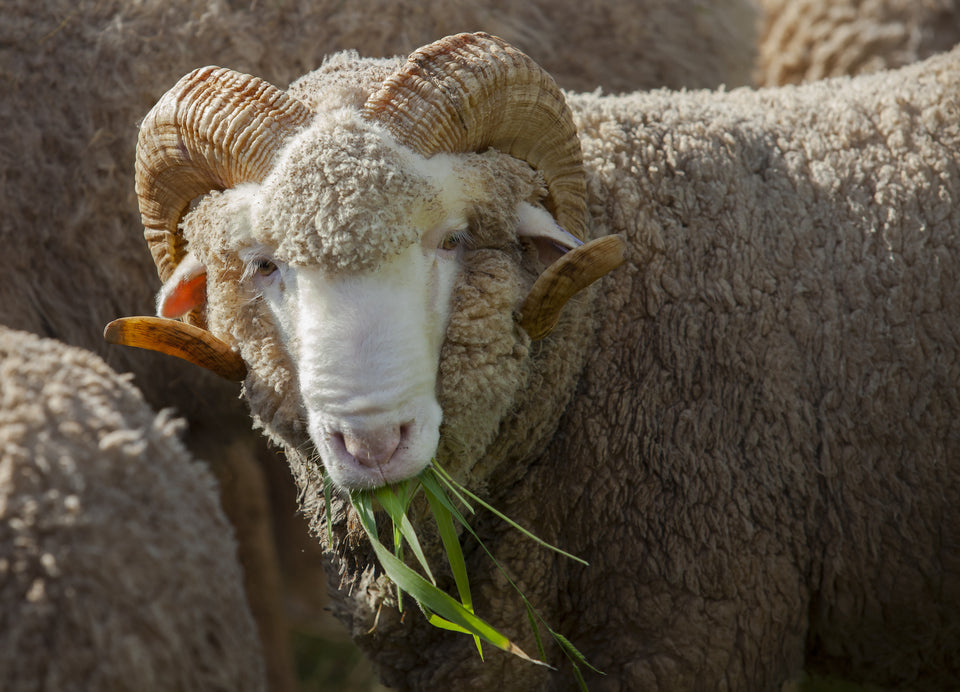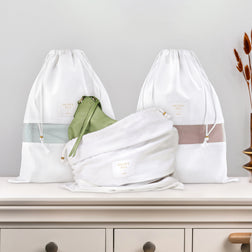When you have invested in your wardrobe and want to extend its longevity, caring and storing it properly is critical. Read this article and follow the steps to salvage your Merino wool garment.
If you’re reading this, you likely have a wool problem on your hands. A favorite sweater that accidentally went through the wrong cycle, knitwear that shrank, or a piece of Merino that no longer fits the way it should.
All is not lost. Your wool item may be restored to its original condition.
Before we walk through how to fix shrinkage, it helps to understand how Merino behaves and why caring for it properly makes such a difference.
Where Does Merino Wool Come From?
Merino wool comes from Merino sheep, a breed believed to have originated in Morocco before becoming established in Spain. For centuries, Spain tightly controlled the export of Merinos, making the wool highly prized.
Today, Merino sheep are raised around the world and must be shorn at least once a year to keep them healthy and prevent overheating.

What Makes Merino Wool So Special?
High quality Merino wool is naturally soft, breathable, and comfortable to wear. Many Merino wool garments are designed as base layers because the fiber adapts easily to changing temperatures, keeping you warm in the cold and cool when it’s warmer.
Each fiber has natural bends that create tiny air pockets, helping trap warmth when you need it. When you start to perspire, Merino wool wicks moisture away from the skin, absorbing sweat and releasing it as vapor. Unlike synthetic fabrics that trap moisture, Merino helps regulate body temperature and keeps you comfortable throughout the day.
What Determines Merino Wool’s Quality
Merino wool quality can vary significantly. Factors such as the environment the sheep are raised in, how the wool is processed, and the purpose the sheep are bred for all influence the final fiber. Wool from sheep bred for mutton is generally coarse and not suitable for clothing, while wool from flocks raised specifically for textile use tends to be finer and softer.
Because quality differs so widely, it’s always best to buy Merino wool garments from trusted retailers who work with reputable producers.
Know Your Wool: Merino vs Other Common Types
In addition to Merino, there are other types of wool such as cashmere and mohair that make excellent garments. In order to know if Merino wool is the right choice for you, let’s compare it with other wool types.

Is Merino the softest wool?
No. Though high-quality Merino wool is soft, it is certainly not the softest wool on the market. The length of a strand of wool and its thickness are good indicators of how soft any given wool garment might be. For softer wools, consider cashmere, angora, or lamb’s wool.
Is Merino the warmest wool?
No. However, warmer wools may only be suitable for outerwear garments, whereas Merino wool is comfortable enough to wear close to the skin.
Is Merino the most expensive wool?
No. Though items made from Merino wool are not cheap, they are certainly not the most expensive wool to buy. Antique rarities aside, the Peruvian vicuna, an animal related to the alpaca, produces the most expensive type of wool in the world.
So, if Merino wool isn’t the softest, the warmest, or the most expensive type of wool, why is it popular? Simply because Merino wool is the best balance of comfort, function, and cost when compared with other types of wool.
Best Practices: How to Wash Merino Wool
If this is your first time washing a wool garment, review our in-depth guides on how to hand-wash or machine-wash your favorite pieces. In the meantime, here are a few quick helpful tips to keep in mind to avoid shrinkage:
-
Start fresh. If you’re hand-washing a garment in a tub, sink, or bucket, then you need to make sure the container is free of anything that could stain or damage the wool. Even if you can’t see anything with the naked eye, it’s best to fully wash and rinse the container before you start hand-washing.
Before using a washing machine to clean the garment, run an empty rinse cycle if you used bleach or harsh chemicals in the cycle prior.
-
Stay cool. As much as possible, keep your wool garments away from heat sources. Don’t use hot or warm water when you wash and rinse, and don’t leave your garment out to dry near a vent or radiator.
-
Wash Merino wool gently. Specifically, use a gentle soap and gentle agitation to wash the garment. You should never scrub or stretch the wool when you wash it. Swirling the water around it gently can help circulate things if you want to make sure you’re cleaning the piece thoroughly.
-
Rinse thoroughly. Don’t let the caution to be gentle cause you to leave behind remnants of soap. Even though wool-safe detergents don’t have any harsh chemicals, any soap can leave a residue that impacts the integrity of a textile. Diluted vinegar rinses can help reduce product build-up too.

- Dry carefully. Just as you should never stretch wool when washing and rinsing it, you should never hang it to dry. The weight of the garment will cause it to lose its shape by stretching out too much in some areas and shrinking up in others.
How To Unshrink Merino Wool Clothing
Now that you know the basics about Merino wool, let’s discuss the problem at hand.
Maybe you forgot to separate your laundry, and your favorite merino wool leggings wound up going through a regular wash and dry cycle leaving you with a pair of baby trousers.
Whatever the circumstance that caused the mishap, the steps necessary to fix your Merino wool item are the same:
-
Fill a tub or sink with lukewarm water.
Moisture, heat, and agitation are the three main reasons Merino wool shrinks. Fortunately, we can use some of those techniques to reverse the shrinking process.
-
Dissolve a generous amount of conditioner in the water.

You can find wool-specific conditioners that are made to help with this process, but many people use their own hair conditioner. It can also help the conditioner and water combine more thoroughly if you add a bit of your usual detergent.
-
Allow the Merino wool garment to soak for several minutes.
You can speed up this process by gently squeezing the garment so that the conditioner can move through every layer properly. A 20-minute soak should be long enough to fully moisturize the item.
-
Squeeze out any extra water; then lay the piece flat on a towel.
If you’re working with an item that’s bigger than your largest towel, you can use a sheet or a blanket. You can also layer another towel, sheet, or blanket on top to assist you in getting out all the excess water.
-
Reshape, then repeat as needed.
After you’re done squeezing out as much water as possible, you’ll need to work carefully in small sections to stretch your garment back to its original shape. You should do this incrementally and in stages before the garment dries completely. Do not use clips or weights to hold any part of the garment in place.
-
Wash and dry the Merino wool item again.
Once you’re satisfied with the reshaping and the garment is completely dry, you will need to wash the remnants of conditioner out of it before you can wear the item or store it again. Be careful to use only cool water and dry the garment flat, away from heat and light sources.

In most cases, following these steps will salvage your Merino wool garment.
When you have invested in your wardrobe and want to extend its longevity, caring and storing it properly is critical.
How to Store Merino Wool to Prevent Damage
After you’ve restored or washed your Merino wool garment, how you store it is just as important as how you wash it.
Merino wool is a natural fiber, which means it needs airflow and gentle protection - especially during long-term storage or seasonal wardrobe changes.
Clean before storing
Any traces of body oils, perfume, or perspiration attract clothes moths. Always wash Merino garments before putting them away for the season.
Fold - never hang
Hanging stretches wool from the shoulders and causes permanent misshaping. Fold garments neatly instead.
Use Breathable Cotton Storage Bags
Natural fibers like wool need airflow. Cotton storage bags keep Merino protected from dust, light, and moisture while allowing the fabric to breathe.
Hayden Hill garment bags made from 100% Organic GOTS Certified Cotton with secure closures and sheer panels that allow you to see what’s inside without exposing garments to full light.
This makes it easier to stay organized and protects the fibers long-term.
Choose a cool, dry, dark place
Merino wool lasts longest when stored away from heat sources, direct sunlight, and humidity.
Prevent clothes moths
Merino wool is one of the fibers moths love most. Discreet clothes moth traps placed nearby offer early detection and peace of mind through the winter months.
Final Touch
When you’ve invested in Merino wool, caring for it properly ensures it lasts for years. Gentle washing, thoughtful drying, and protective storage all work together to preserve the softness, shape, and quality of the pieces you love most.










